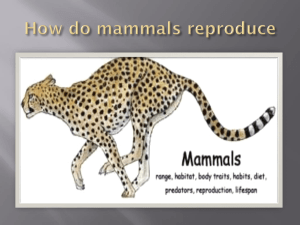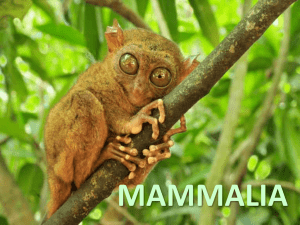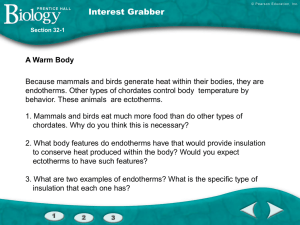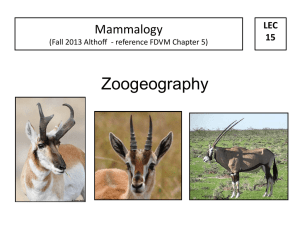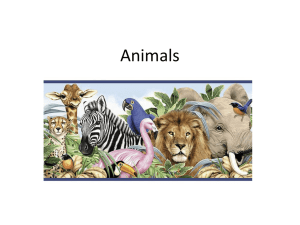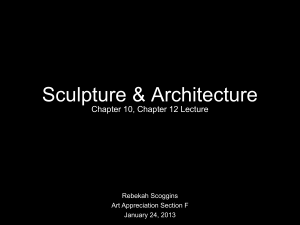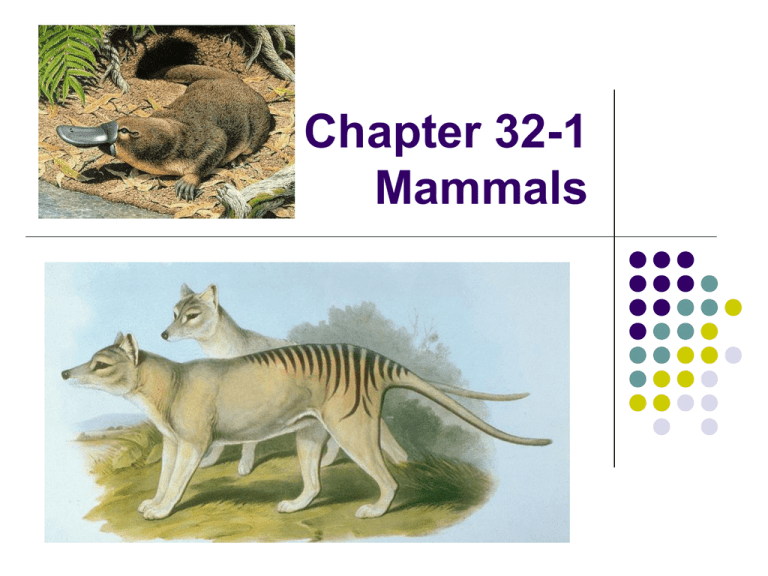
Chapter 32-1
Mammals
32-1 Introduction to the Mammals
Copyright Pearson Prentice Hall
Derived Characteristics: ALL Mammals
Mammary glands
Endotherms
Hair & Teeth
4 chambered
heart
Enucleated RBC
Muscular
diaphragm
Characteristics: MOST Mammals
1. Live birth
2. Corpus
Callosum
3. Placenta
What are Mammals?
Hair, providing
insulation,
waterproofing,
& camouflage
Mammary glands,
modified sweat glands,
to nurse their young
What are Mammals?
Mammals have well-developed respiration &
circulation to maintain high energy needs:
Diaphragm, breathing
muscle expands chest
to bring in more oxygen
Four-chambered heart
What are Mammals?
Mammals lifestyle is determined by:
Specialized teeth
adapted to the type
of food they eat
Specialized limbs
adapted to methods
of food-gathering
What are Mammals?
Mammals are endotherms –they
generate their own heat internally.
Skin & Hair
Integument “Skin” (outer boundary)
1. Color
variation of skin
2. Dominance
displays
a.Sun protection
3. Provides
protection by
derivatives such
as hooves, claws,
nails, horns and
antlers.
4. Holds hair/fur:
(evolved from scales)
5. Holds glands
a. Sweat
b. Sebaceous
c. Scent
Hair
Horns & Antlers
Evolution of Mammals
Evolution
of Mammals
Mammalian
fossils are characterized by a lower
jaw with a large, teeth-bearing bone connected
directly to the skull by a joint, and distinctive
features of the limbs and the backbone.
Copyright Pearson Prentice Hall
Evolution of Mammals
Skull Characteristics
1. Nasal size related to
reliance on sense of smell.
2. Large ears
3. Eyes in front vs. eyes on side.
Evolution of Mammals
Mammals
are descended from ancient reptiles.
Ancestors of modern mammals diverged from
ancient reptiles during the Carboniferous Period.
For millions of years, various mammal-like
reptiles lived alongside other reptile groups.
Copyright Pearson Prentice Hall
Evolution of Mammals
The
first true mammals appeared during the late
Triassic Period, about 220 million years ago.
These
mammals were very small and probably
nocturnal.
Copyright Pearson Prentice Hall
Evolution of Mammals
After
the extinction of dinosaurs, mammals
underwent an adaptive radiation.
They increased in size and occupied many
new niches.
The Cenozoic Era is called the Age of
Mammals.
Copyright Pearson Prentice Hall
Form and Function in Mammals
Body
Temperature Control
Mammals are endotherms.
A high rate of metabolism helps mammals
generate body heat.
Mammals have external body hair that helps
them keep warm.
Subcutaneous fat, which is a layer of fat
located beneath the skin, also helps conserve
body heat.
Copyright Pearson Prentice Hall
Form and Function in Mammals
Many
mammals have sweat glands that help
cool the body.
If its body temperature gets too high, the mammal
sweats.
Evaporation of sweat then cools the body.
Some mammals pant to cool down.
Copyright Pearson Prentice Hall
Glands
Form and Function in Mammals
The
ability of mammals to regulate their body
heat from within is an example of homeostasis.
Copyright Pearson Prentice Hall
Form and Function in Mammals
Feeding
Because
of its high metabolic rate, a mammal
must eat a lot of food to maintain homeostasis.
Some mammals are herbivores. Some
mammals are carnivores. Some mammals,
including humans, are omnivores.
Certain whales are filter feeders.
Copyright Pearson Prentice Hall
Form and Function in Mammals
As
mammals evolved, the form and
function of their jaws and teeth became
adapted to eat foods other than insects.
The joint between the skull and lower jaw
allowed mammals to evolve larger, more
powerful jaw muscles and different ways
of chewing.
Copyright Pearson Prentice Hall
Form and Function in Mammals
Jaws and Teeth of Mammals
Carnivore
Herbivore
Canines
Jaw
joint
Wolf
Incisors
Molars and premolars
Copyright Pearson Prentice Hall
Jaw
joint
Horse
Form and Function in Mammals
Canines:
Canines are pointed teeth. Carnivores
use them for piercing, gripping, and tearing. In
herbivores, they are reduced or absent.
Canines
Wolf
Horse
Copyright Pearson Prentice Hall
Form and Function in Mammals
Incisors:
Chisel-like incisors are used for
cutting, gnawing, and grooming.
Wolf
Incisors
Copyright Pearson Prentice Hall
Horse
Form and Function in Mammals
Molars
crush and grind food. The ridged shape of
the wolf’s molars and premolars allows them to
interlock during chewing, like the blades of scissors.
The broad, flattened molars and premolars of
horses are adapted for grinding tough plants.
Wolf
Molars and premolars
Copyright Pearson Prentice Hall
Horse
Feeding
Form and Function in Mammals
A
mammal’s digestive tract breaks down and
absorbs the type of food that it eats.
Carnivores have a short intestine because
enzymes quickly digest meat.
Herbivores have a longer intestine because
tough, fibrous plant tissues take longer to
digest.
Copyright Pearson Prentice Hall
Feeding
Form and Function in Mammals
Feeding
Cows
have a stomach chamber called the
rumen, in which swallowed plant food is stored
and processed.
It contains bacteria that digest the cellulose of
plant tissues.
Copyright Pearson Prentice Hall
Form and Function in Mammals
Respiration
All
mammals use lungs to breathe.
A diaphragm is a large, flat muscle at the
bottom of a mammal’s chest cavity that helps in
breathing.
Copyright Pearson Prentice Hall
Form and Function in Mammals
When
an animal inhales, chest muscles lift the
rib cage up and out. The diaphragm pulls the
chest cavity down.
The combined actions of the chest muscles
and diaphragm increase the volume of the
chest cavity.
The increase in volume pulls air into the lungs.
Copyright Pearson Prentice Hall
Form and Function in Mammals
When
an animal exhales, chest muscles lower
the rib cage. The diaphragm relaxes, and the
volume of the chest cavity decreases.
Air is then pushed out of the lungs.
Copyright Pearson Prentice Hall
Form and Function in Mammals
Circulation
The
mammalian circulatory system has two
loops and a four-chambered heart.
The right side of the heart receives oxygen-poor
blood from the body and pumps it to the lungs.
The left side receives oxygen-rich blood from
the lungs and pumps it to the rest of the body.
Copyright Pearson Prentice Hall
Form and Function in Mammals
Mammalian
heart
Left atrium
Right atrium
Left ventricle
Right ventricle
Complete
division
Copyright Pearson Prentice Hall
Form and Function in Mammals
Excretion
Kidneys
extract nitrogenous wastes from the blood in the
form of urea.
Urea, other wastes, and water combine to form urine.
From the kidneys, urine flows to a urinary bladder, where it
is stored until it is eliminated.
Copyright Pearson Prentice Hall
Form and Function in Mammals
The
kidneys of mammals help maintain
homeostasis by filtering urea from the blood,
as well as by excreting excess water or
retaining needed water.
Copyright Pearson Prentice Hall
Form and Function in Mammals
The
kidneys control the amount of water in the
body.
This enables mammals to live in many
habitats in which they could not otherwise
survive.
Copyright Pearson Prentice Hall
Form and Function in Mammals
Response
Mammals
have well-developed brains with three main
parts:
cerebrum—controls thinking and learning
cerebellum—controls muscular coordination
medulla oblongata—regulates involuntary body
functions
Copyright Pearson Prentice Hall
Form and Function in Mammals
Mammalian
Brain
Copyright Pearson Prentice Hall
Form and Function in Mammals
The
cerebrum has a well-developed outer
layer called the cerebral cortex, which is the
center of thinking and other complex behaviors.
Some behaviors, such as reading, are
possible only with the human cerebral cortex.
Mammals other than humans also exhibit
complex behaviors.
Copyright Pearson Prentice Hall
Form and Function in Mammals
Mammals
rely on highly developed senses to
detect and respond to stimuli from their external
environment.
Many have well-developed senses of smell
and hearing.
Copyright Pearson Prentice Hall
Form and Function in Mammals
All
mammalian ears have the same basic
parts, but they differ in their ability to detect
sound.
Dogs, bats, and dolphins detect sounds at higher
frequencies than humans can.
Elephants detect sounds at much lower frequencies.
Copyright Pearson Prentice Hall
Form and Function in Mammals
The
ability to distinguish colors varies among
species.
Color vision is most useful to animals that are
active during the day.
Copyright Pearson Prentice Hall
Form and Function in Mammals
Chemical
Controls
Mammals
have endocrine glands that regulate body
activities by releasing hormones.
Hormones are substances produced in one part of an
organism that affect another part of the same organism.
Hormones are carried by the blood to the organs that they
affect.
Copyright Pearson Prentice Hall
Form and Function in Mammals
Fighting
Disease
The
immune system helps protect animals from disease.
Barriers, such as the skin, prevent pathogens from
entering the body.
Specialized cells and chemicals recognize and destroy
pathogens.
Copyright Pearson Prentice Hall
Form and Function in Mammals
Movement
Mammals
have backbones that flex vertically and side to
side.
Shoulder and pelvic girdles are streamlined and flexible,
permitting both front and hind limbs to move in many ways.
Variations in limb bones and muscles permit a variety of
movements.
Copyright Pearson Prentice Hall
Form and Function in Mammals
The limbs and digits (fingers and toes) of many
mammals are adapted to their particular way of life.
Note the variety of lengths and shapes of the limb
bones. Homologous bones are the same color in all
the drawings.
Monkey
Horse
Mole
Copyright Pearson Prentice Hall
Bat
Seal
Flight and Echolocation
Flight and Echolocation
Locomotion
1. Cursorial
2. Ambulatory
4. Oscillatory
amphibious
3. Saltatorial
aquatic
marine
7. Arboreal
8. Fossorial
5. Volant
6. Gliding
(could be arboreal)
Form and Function in Mammals
Reproduction
Mammals
reproduce by internal fertilization.
The male deposits sperm inside the reproductive tract of
the female, where fertilization occurs.
All newborn mammals feed on their mother’s milk.
Copyright Pearson Prentice Hall
Form and Function in Mammals
Young
mammals need care from one or both
parents when they are born and for a long time
afterward.
Parental care ensures that young will survive
and reproduce.
The duration and intensity of parental care varies
among different species.
Copyright Pearson Prentice Hall
Form and Function in Mammals
Some
mammal species, such as lions, live in
groups in which the young may be cared for by
adults other than the parents.
Group living provides young mammals with
complex social interaction among adults and
juveniles.
Copyright Pearson Prentice Hall
32-1 Quiz
Copyright Pearson Prentice Hall
32-1
One
characteristic commonly used to determine
whether fossils are mammals is
subcutaneous fat.
mammary glands.
a jaw joint that allows movement from side to side.
hair or fur.
Copyright Pearson Prentice Hall
32-1
How
many chambers do mammalian hearts
have?
2
3
4
6
Copyright Pearson Prentice Hall
32-1
Mammals
are called endotherms because they
produce milk to nourish their young.
have well-developed sense organs.
have powerful jaws and specialized teeth.
generate their body heat internally.
Copyright Pearson Prentice Hall
32-1
The
first true mammals appeared in the fossil
record
soon after the extinction of the dinosaurs.
about the same time as the first reptiles.
during the Triassic when dinosaurs were the
dominant land animals.
long after the extinction of the dinosaurs.
Copyright Pearson Prentice Hall
32-1
The
duration of parental care in mammals
varies among different species.
is one to four weeks.
is six months to a year.
is intermediate compared to reptiles.
Copyright Pearson Prentice Hall
END OF SECTION

